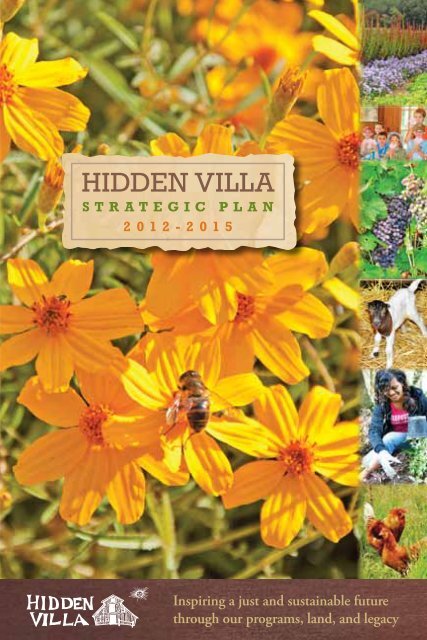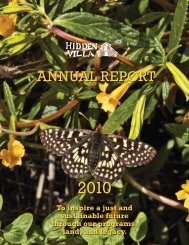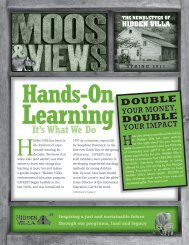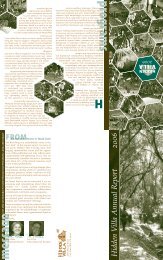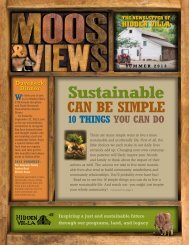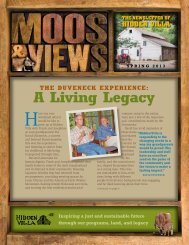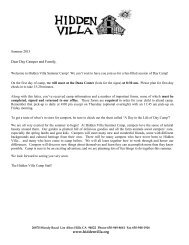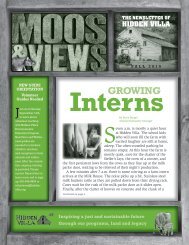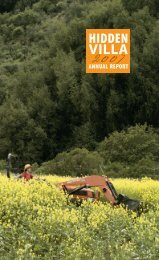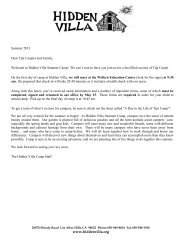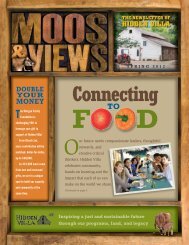Strategic Plan 2012-2015 - Hidden Villa
Strategic Plan 2012-2015 - Hidden Villa
Strategic Plan 2012-2015 - Hidden Villa
Create successful ePaper yourself
Turn your PDF publications into a flip-book with our unique Google optimized e-Paper software.
HIDDEN VILLA<br />
STRATEGIC PLAN<br />
<strong>2012</strong>-<strong>2015</strong><br />
Inspiring a just and sustainable future<br />
through our programs, land, and legacy
Dear Friends and Supporters,<br />
It is with much excitement and pride that we share this next phase of<br />
<strong>Hidden</strong> <strong>Villa</strong>’s <strong>Strategic</strong> <strong>Plan</strong> with you. Our dedicated Board, staff,<br />
volunteers and community partners have been working over the past year<br />
on a process of evaluation, assessment and planning for the future.<br />
Our mission “to inspire a just and sustainable future through our programs,<br />
land and legacy” captures the spirit of <strong>Hidden</strong> <strong>Villa</strong> so completely that we<br />
decided to use these categories of “Programs,” “Land,” and “Legacy” as our<br />
major themes; as responsible stewards, we have added a fourth category<br />
of “Fiscal Sustainability.”<br />
The Board and staff at <strong>Hidden</strong> <strong>Villa</strong> have<br />
focused on ensuring that this <strong>Plan</strong>, informed<br />
and inspired by our mission, is the roadmap<br />
that will set the course for the future of the<br />
organization. We’re happy to report that all<br />
of the work included in our last two <strong>Strategic</strong><br />
<strong>Plan</strong>s is on track to be completed and that<br />
we are now poised to delve into the next<br />
three years.<br />
Here are some of the initiatives that we’ll be focusing on during the next<br />
three years:<br />
Programs: Two exciting areas of growth within the organization are our Residential<br />
Internship and Youth Development Programs. We are expanding our<br />
internship opportunities to include Development, Sustainable Land Management,<br />
and Youth Development in addition to Agriculture, Animal Husbandry,<br />
Environmental Education, and Community Programs. Our Youth Development<br />
Program is planning to reach even more at risk, underserved youth with<br />
programs designed to help them build skills that will set them up for greater<br />
success in school and, more importantly, in life.<br />
Land: <strong>Hidden</strong> <strong>Villa</strong>’s land is a tremendously valuable resource, and we take<br />
its stewardship very seriously. Over the next three years we plan to increase<br />
both internal and community-based education concerning land conservation<br />
ethics and also to adopt a conservation hydrology model that will inform our<br />
ongoing practices for water use.<br />
Legacy: In keeping with the Duveneck Family legacy of activism around<br />
social justice issues, we will be developing and hosting a series of “Duveneck<br />
Forums,” which will be open to the public. These forums will celebrate the<br />
family’s legacy of social activism and inform the public about ways in which<br />
they can get more actively involved in making positive changes in society.
Fiscal Sustainability: In order to ensure the sustainability of our programs<br />
and scholarships, we must have a solid financial plan to support the organization.<br />
We are committed to ensuring that our programs remain accessible to<br />
all and have developed a range of creative and engaging initiatives to enable<br />
us to identify and secure the necessary funding from supporting individuals,<br />
foundations and Corporations that provides approximately half of our current<br />
operating budget (approximately $1.3M in support).<br />
<strong>Hidden</strong> <strong>Villa</strong> is a unique place and organization, and it can be a challenge<br />
to capture and articulate everything that makes it so special. We are grateful to<br />
Wallace Stegner, Pulitzer Prize-winning author and former <strong>Hidden</strong> <strong>Villa</strong> Board<br />
member, for his description:<br />
It does not matter whether one interprets the activities of <strong>Hidden</strong> <strong>Villa</strong> as the<br />
supplying of a missing element in American life or as the reinforcement of tendencies<br />
once strong but in danger of being obliterated by urbanization and technology.<br />
Either way, <strong>Hidden</strong> <strong>Villa</strong> performs an indispensable function. In a time when<br />
the health of the earth is too often forgotten or disregarded, it brings to children<br />
(and their parents, and their teachers) the commitment to earth citizenship and<br />
stewardship. In a time of ethnic, cultural, and religious discord, it gives children the<br />
experience of living and learning together, in equality and harmony, in the company<br />
of the good earth. In a time of increasing and dehumanizing urbanization, it makes<br />
possible for hundreds of young people each year the experience of putting foot to<br />
natural ground, learning and accepting the animals of the wild and the farm, and<br />
learning something of the intricate interdependency upon which human life and<br />
all other life is built. It restores, for however few and however briefly, a degree of<br />
wholeness to the adventure of growing up in America.<br />
Through these experiences, this sharing, this uncovering of the natural world and<br />
the revelation of our obligated part in it, <strong>Hidden</strong> <strong>Villa</strong> tries to build, sustain, and<br />
enhance a vision of the community of life. October 1981<br />
It’s remarkable just how appropriate and relevant Wallace Stegner’s words<br />
remain today and of course, we couldn’t have said it any better ourselves!<br />
Many thanks to each and every one of you, our friends and supporters, for<br />
your commitment to <strong>Hidden</strong> <strong>Villa</strong> and our ongoing mission “to inspire a just<br />
and sustainable future through our programs, land and legacy.”<br />
Bill Whitmer,<br />
Board Chair<br />
Chris Overington<br />
Executive Director
<strong>Hidden</strong> <strong>Villa</strong><br />
<strong>Hidden</strong> <strong>Villa</strong> is a nonprofit educational organization that uses its organic<br />
farm, wilderness, and community to teach and provide opportunities to<br />
learn about the environment and social justice. <strong>Hidden</strong> <strong>Villa</strong> stretches<br />
over 1600 acres of open space in the foothills of the Santa Cruz Mountains, about<br />
40 miles south of San Francisco.<br />
Our mission is to inspire a just and sustainable future through our programs,<br />
land and legacy.<br />
<strong>Hidden</strong> <strong>Villa</strong> was founded by Frank and Josephine Duveneck, who purchased<br />
the land in 1924 and offered it as a gathering place for discussion, reflection, and<br />
incubation of social reform. Over the following decades, the Duveneck family<br />
established the first American Youth Hostel on the Pacific Coast (1937), the first<br />
deliberately/consciously multiracial summer camp in the United States (1945),<br />
and <strong>Hidden</strong> <strong>Villa</strong>’s Environmental Education Program (1970). The Trust for<br />
<strong>Hidden</strong> <strong>Villa</strong> was established as a nonprofit in 1960.<br />
Whom We Serve<br />
Participants in <strong>Hidden</strong> <strong>Villa</strong>’s on-site activities live primarily in Santa Clara and<br />
San Mateo Counties, although we do also attract participants and visitors from all<br />
around and outside the San Francisco Bay Area.<br />
Guiding Principles<br />
1. We deliver a wide variety of relevant educational experiences that teach people<br />
respect for the environment and for each other.<br />
2. We encourage program participation from diverse communities.<br />
3. We engage diverse elements of the community to participate in the design,<br />
implementation, delivery, and evaluation of our programs and services.<br />
4. We build alliances with other organizations in the community to optimize<br />
resources and deepen our impact.<br />
5. We care for and sustain the natural, human, and financial resources entrusted to<br />
us, as well as the living legacy inspired by the Duveneck family.<br />
2
What we’ve accomplished…<br />
To give you some context for our current plan, here are a few of the major accomplishments<br />
from our last three year <strong>Strategic</strong> <strong>Plan</strong> (2009-<strong>2012</strong>).<br />
We have….<br />
• Created a closer alignment of our environmental education themes (both in<br />
onsite programs and offsite school partnerships) with the State Science Standards<br />
Framework.<br />
• Developed more appropriate signage, which is both interpretative and<br />
educational (ongoing).<br />
• Fostered cross-departmental initiatives that provide education about healthier<br />
food choices and sustainable farming.<br />
• Expanded our “food security” partnership with the Mountain View Community<br />
Services Agency.<br />
• Developed a continuum of Middle/High School programs in Redwood City that<br />
are focused on developing green collar job training opportunities.<br />
• Cultivated a closer relationship with Foothill and De Anza Colleges and now offer<br />
college classes and continuing education as an integrative part of our residential<br />
internship program.<br />
• Developed”externship” experiences and classes that allow our interns to<br />
broaden their education, rotate between departments at <strong>Hidden</strong> <strong>Villa</strong>, and create<br />
individualized projects to further enhance their career development.<br />
• Provided greater educational enrichment opportunities for volunteers to expand<br />
their knowledge base and skill set.<br />
• Updated our website to enhance its capabilities and make it more attractive and<br />
user friendly.<br />
• Upgraded our online curricula, now accessible via our website, and developed<br />
supporting workshops for school teachers and other educators.<br />
• Built more intentional relationships with corporations through a comprehensive<br />
Corporate Social Responsibility plan.<br />
• Implemented a more effective social media and networking strategy.
In the following pages we’ll share highlights of the four strategic themes we<br />
will be focusing on over the next three years. These themes: Programs, Land,<br />
Legacy and Fiscal Sustainability capture the main components of the work we<br />
do to fulfill our mission of inspiring a just and sustainable future.<br />
Programs:<br />
1. Partnerships with other organizations<br />
• Create a <strong>Strategic</strong> Partnerships plan.<br />
• Define standards and a process for the development and ongoing evaluation of<br />
organizational partnerships.<br />
• Develop Annual <strong>Plan</strong>s with specific deliverable goals with our current major<br />
partners: Heifer International, The Children in Nature Collaborative, and The<br />
Mountain View-Whisman and Redwood City Unified School Districts.<br />
2. Environmental Education<br />
• Fully integrate <strong>Hidden</strong> <strong>Villa</strong>’s Environmental Educational Program (HVEEP),<br />
Community Programs and our offsite Partner School Programs.<br />
• Expand our Food and Nutrition programming to address child health issues by:<br />
– Partnering with food advocates<br />
– Developing curricula for young learners<br />
– Introducing stand alone offsite school programs<br />
• Address the barrier of transportation costs that keeps some community members<br />
from accessing <strong>Hidden</strong> <strong>Villa</strong>, through the development of transportation<br />
partnerships and/or the use of corporate shuttles.<br />
• Enhance Staff/Intern/Volunteer expertise in ecology and natural history through<br />
the creation of a Naturalist Certification Program.
3. Internships<br />
• Increase the time and resources available for the Internship coordinator to better<br />
manage the expanded Internship program.<br />
• Evaluate and expand the role and range of “externships.”<br />
• Evaluate the benefits and costs of second year Internships.<br />
• Expand and enhance the current Alumni program to keep former Interns<br />
connected to <strong>Hidden</strong> <strong>Villa</strong> and to serve as networking resources for future<br />
Interns.<br />
• Expand Internship opportunities in Development, Sustainable Land Management,<br />
and Youth Development.<br />
4. Youth Development<br />
• Build on our current success in developing strong, replicable programs. Define<br />
outcomes so that we can measure success.<br />
• Increase our fee-paying client base.<br />
• Develop programmatic sustainability through additional staff, volunteers and/or<br />
consultants.<br />
5. Evaluation Initiative<br />
• Engage a working group of the Mission Fulfillment committee to conduct a<br />
thorough assessment of the metrics (both quantitative and qualitative) that are<br />
currently employed to evaluate the success of our programs.<br />
• Identify existing best practices and instruments within this field and develop a<br />
set of recommendations for improvements and enhancements in this area.<br />
• Implement these improved metrics and processes over time both to improve<br />
programs and evaluate the extent to which our programs are fulfilling the<br />
organizational mission.<br />
5
Land:<br />
1. Environmental Advocacy<br />
• Expand our educational offerings in conservation ethics, including the use of best<br />
management practices for staff and volunteers through trainings and forums.<br />
• Showcase interpretive models of conservation in action, such as gray water<br />
filtration systems, root cellars and bio-swales.<br />
• Improve energy conservation within our existing buildings, outdoor areas, and<br />
systems (enhanced insulation, solar showers) and research other appropriate<br />
initiatives, such as composting toilets.<br />
• Increase our solar power generation capacity (and potentially add an electric<br />
vehicle charging station), with a focus on panel installation on existing buildings.<br />
2. Water Conservation<br />
• Adopt a conservation hydrology model that focuses on reducing the rate of water<br />
flow, enhancing rainfall infiltration, and following best practices regarding water<br />
use, including more drip irrigation systems and the replacement of some of our<br />
existing plumbing systems.<br />
• Develop an interim flood/drought plan for contingency purposes.<br />
• Add additional water swales as appropriate to facilitate greater infiltration.<br />
• Retain a “rehabitation” consultant regarding Adobe Creek, including fundraising.<br />
3. Develop a long-term Capital Needs Assessment <strong>Plan</strong><br />
(and multi-year budget)<br />
6
4. Public Access<br />
• Improve public safety by replacing existing speed bumps to reduce vehicular<br />
speed on the property.<br />
• Improve visitor experience through enhanced interpretive materials that provide<br />
valuable informational content with minimal visual impact.<br />
5. Information Technology<br />
• Assess current IT resources, including dedicated staffing.<br />
• Develop and implement an organization-wide plan for improved internet<br />
connectivity.<br />
• Focus on existing databases and develop more effective methods of warehousing<br />
and information sharing, especially in consultation with the Development<br />
Department.
Legacy:<br />
1. Advocacy<br />
• Develop and implement a Duveneck Forum series focused on our legacy of<br />
addressing issues around social justice.<br />
• Create a framework for the evaluation of <strong>Hidden</strong> <strong>Villa</strong>’s social justice programs,<br />
offerings and advocacy, and form recommendations for change based on those<br />
findings.<br />
• Design a basic and inclusive set of guidelines and tools for staff, Board, and<br />
departments to use to facilitate understanding of and participation in mutual<br />
definitions of social justice and advocacy.<br />
• Develop measurable outcomes based on <strong>Hidden</strong> <strong>Villa</strong>’s definition of social<br />
justice and advocacy to meet the needs of changing programs and to encourage<br />
continued active participation in the self examination process.<br />
2. Family History<br />
• Provide greater information on the history of the Duveneck family, using<br />
materials donated from the Los Altos History Museum.<br />
• Develop public programs that highlight and celebrate the Duveneck family<br />
legacy, particularly in areas of social activism.<br />
• Digitize and edit the existing Duveneck family video archives and develop<br />
protocols for sharing highlights on our website.<br />
3. Youth Development Initiatives<br />
• Bring high school-aged youth from a variety of cultures and backgrounds<br />
together through a range of integrative day and residential programs, to enable<br />
them to develop a greater understanding of and appreciation and respect for both<br />
the beauty of their diversity and their shared experiences, values and needs as<br />
young adults.<br />
• Address the developmental asset needs of underserved youth resulting from<br />
immigration status, previous legal issues or gender bias.<br />
• Develop partnerships with other organizations to design and implement powerful<br />
programs to help young adults to build support networks and gain the skills<br />
they need to become more effective in contributing to meeting the needs of their<br />
communities.
Fiscal Sustainability:<br />
1. Governance<br />
• Evaluate the current Board meeting structure/process.<br />
• Develop and host a Blue Ribbon Lunch for cultivation.<br />
• Implement an Annual Board Development <strong>Plan</strong>.<br />
2. Development<br />
• Define and adopt a Donor Bill of Rights.<br />
• Evaluate and enhance the vehicles currently used to communicate with donors.<br />
• Broaden our individual donor base through a greater emphasis on our programs<br />
and their impact on participants.<br />
• Better integrate social media into our fundraising efforts through the use of “day<br />
challenge” matches with existing donors.<br />
3. Investment Management<br />
• Evaluate and edit our existing policy as appropriate.<br />
• Consider the engagement of an external Fund Manager.<br />
4. Ropes Course<br />
• Upgrade and enhance our existing ropes course for use in the engagement of<br />
Corporate supporters.<br />
• Similarly use the upgraded course as a more integral element within our Summer<br />
Camp and Youth Development programs.<br />
5. Continue to develop additional revenue generating<br />
opportunities from currently unencumbered land.<br />
9
How to Get Involved!<br />
Take a class<br />
We have a wide array of hands-on classes that connect you, and the entire family,<br />
to our food, watershed and eco systems. www.hiddenvilla.org/calendar.<br />
Explore the Farm & Wilderness<br />
So much to do and see at <strong>Hidden</strong> <strong>Villa</strong> — please visit our website<br />
www.hiddenvilla.org.<br />
Share Your Time and Build a Team<br />
What could be better than a day on the farm? Come make a difference and have<br />
fun all at the same time. Service projects and ropes course; Share your objectives<br />
and we will design a day to strengthen your team. For more information<br />
about volunteering and team building activities please contact<br />
volunteers@hiddenvilla.org or call (650) 949-8652.<br />
Invest Your Resources<br />
When you make a gift to <strong>Hidden</strong> <strong>Villa</strong> you expand our ability to inspire a just and<br />
sustainable future. You make our programs and scholarship opportunities possible.<br />
Join our Online Community!<br />
Learn about upcoming events, discover opportunities and share what inspires you.<br />
Sign up for our online newsletter at www.hiddenvilla.org<br />
Like us at www.facebook.com/hiddenvilla<br />
Follow us at www.twitter.com/hiddenvilla<br />
Become a Season Pass Holder<br />
By investing in a Season Pass you help <strong>Hidden</strong> <strong>Villa</strong> steward our land and reinforce<br />
the value this place has for you and your community. A Season Pass permits one<br />
car to skip the usual $5 parking fee and park in our lot during our public operating<br />
season (September through May and select open weekends in the summer). They<br />
also make a great gift for hikers, joggers, families with children and regular visitors.<br />
10
Acknowledgements<br />
Special thanks to the Morgan Family Foundation for their generous support of our<br />
<strong>Strategic</strong> <strong>Plan</strong>ning process.<br />
Many thanks also to the Board, staff and community stakeholders who dedicated<br />
so many hours working to plan for <strong>Hidden</strong> <strong>Villa</strong>’s future!<br />
Board of Trustees<br />
Eric Chang<br />
Edgar Chavez<br />
Mary Colvig<br />
Mai Dam<br />
David Duveneck<br />
Joe Eandi<br />
Jeremy Eddy<br />
Jerome Elkind<br />
Sally Falkenhagen<br />
Diane Greenberg<br />
Michael Hamilton<br />
Shehzad Merchant<br />
Martin Neiman<br />
Richard Peers<br />
Stew Plock<br />
Nobuko Saito Cleary<br />
Bob Sator<br />
Justin Sears<br />
Beth Steinberg<br />
Leah Sutton<br />
Richard Thornton<br />
Peter Thurston<br />
David Ulate<br />
Bill Whitmer<br />
Rita Whitney<br />
Community<br />
members<br />
Sumbul Ali-Karamali<br />
Lysbeth Goodman<br />
Dan Quinn<br />
Kathie Underdal<br />
Diane Ciesinski<br />
Carl King<br />
Tom Livermore<br />
Marita Vargas<br />
Staff<br />
Suzanne Allcroft<br />
Nathalie Arch<br />
Nikki Bryant<br />
Liz Babbs<br />
Elizabeth Binkley<br />
Armando Carrillo<br />
Daniel Chmielewski<br />
Karen Chmielewski<br />
Margaret Davis<br />
Bill Dudley<br />
Nathan Hammer<br />
Garth Harwood<br />
Nicolette Heaphy<br />
Sandra Hutchings<br />
Taylor Hutchinson<br />
Bryden Johnston<br />
Pliny Keep<br />
Aspen Kvicala<br />
Samantha Langevin<br />
Susan Love<br />
Jason McKenney<br />
Milly Maples<br />
Kate Marland<br />
Jake Mendell<br />
Chris Overington<br />
Jessica Peralez<br />
Stacey Poncia<br />
Dan Ronco<br />
Jake Salt<br />
Molly Stermer<br />
Kimi Schell<br />
Tenaya Schnare<br />
Maggie Shields<br />
Marc Sidel<br />
Blair Thompson<br />
Diana Vasquez<br />
Diny van der Velden<br />
Serena Wagner<br />
Josie Watson<br />
Lucy Zhang<br />
Photography: Laurie Aubuchon and Lucy Zhang<br />
This brochure is made possible by a generous donation from Alexander Atkins Design, Inc.
26870 Moody Road<br />
Los Altos Hills, CA 94022<br />
www.hiddenvilla.org


